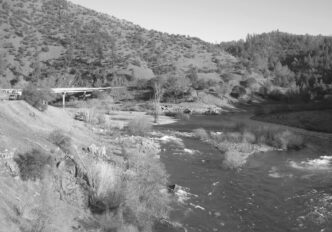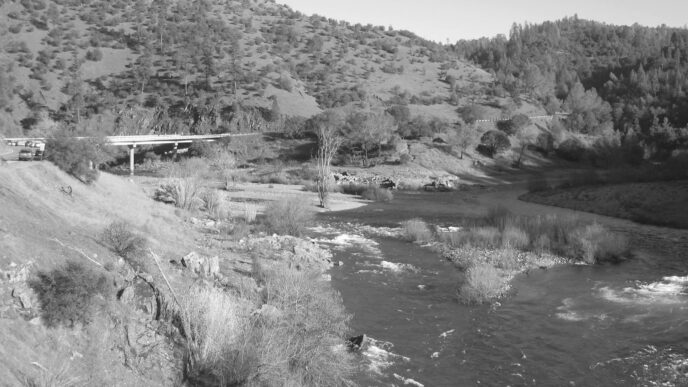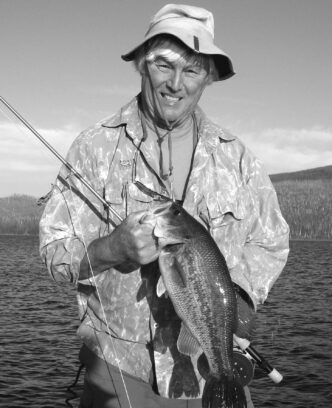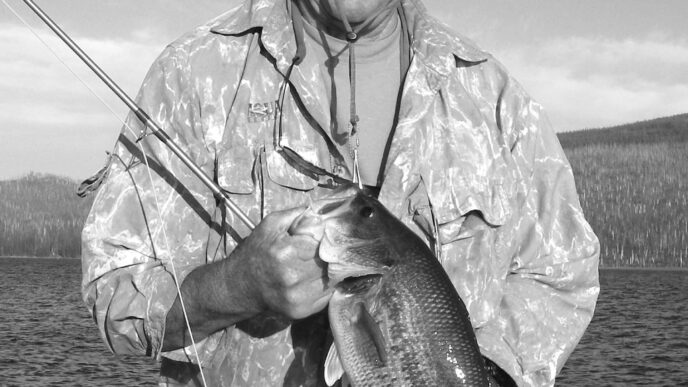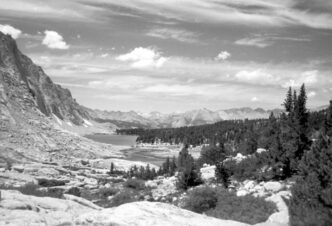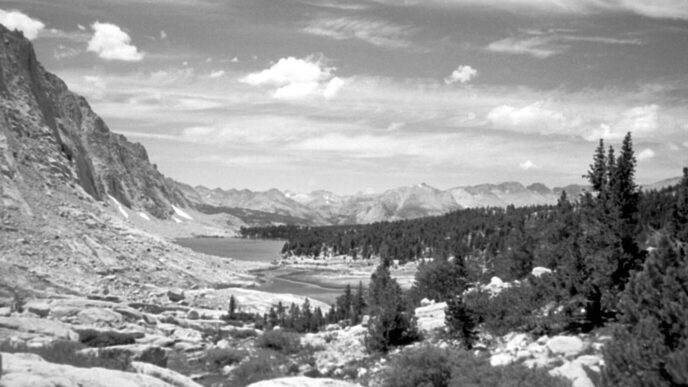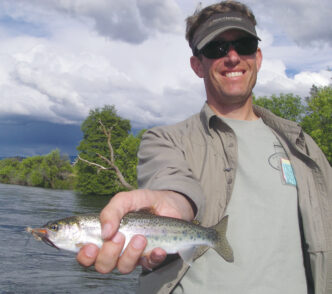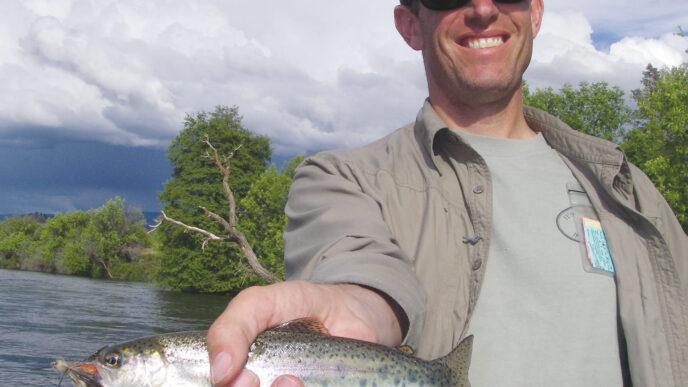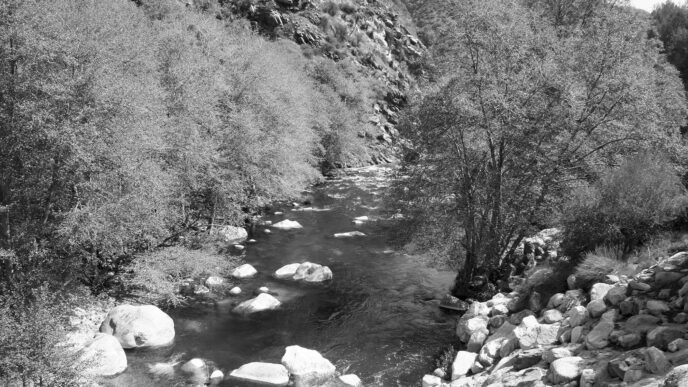Earlier this winter, I had planned a day on the lower Yuba River. It is 25 minutes down the mountain from my house, but a snowstorm came in overnight and dumped eight inches of the white stuff. The snow didn’t bother me, but reports of black ice suggested that it would be wise to stay home. I rescheduled for the next day with my fishing partner, shoveled myself out that morning, and we were at the river by 11:30. That sounds late, but at this time of the year, there is a window that lasts from around noon to 2:00 P.M. The fish work off an unseen alarm clock, and they want every bit of the winter’s brightest sunshine, however little there may be.
My wife made a pot of potato and leek soup and sent me off with a thermos. The air temperature at my home was 24 degrees. At streamside, it was a balmy 37, and we had the river to ourselves. A mixture of thin clouds, bright sunshine, and an no wind launched an armada of Blue-Winged Olives and Pale Morning Duns. Both of us took three credible fish on dries, and we lost a few more.
That thermos of hot soup charged my battery, and a fabulous day of winter angling with snow on the ground and backlit purples and reds on the hillsides made me think about some earlier experiences. It happens that many of my most treasured moments on the water seem to center on a memorable meal tucked in somewhere . . . often surrounded by inclement weather.
Longtime angling partner Roger Lawson was a navy carrier pilot in the Vietnam War and later flew big birds for American Airlines. Roger was a superb angler and fly tyer, and my fishing buddies and I just liked being with him, but even more, we appreciated his love of life and the fact that when he made the Boston run, he would return with live lobsters. One spring many years ago, my friends and I were on the Yuba looking for early shad. A late-season winter storm came down from Alaska, and instead of wearing shorts and short-sleeved shirts, we had on rain jackets and layers of clothing.
Roger had arranged to drive directly from the airport in San Francisco and meet us in the gold fields sometime that day. Late in the morning, we heard a honk, and the familiar Jeep pulled out onto our gravel bar. We wondered why he took so long to get his waders on and join us in the line. The reason was that he had a box full of live, squirming Maine crustaceans in the back of his car.
Soon, he had stretched and anchored a tarp for shelter, and out came a propane stove and a big stainless steamer kettle. Red napkins, a checkered tablecloth, and six director’s chairs graced a folding table. He produced a box of wine glasses, a chilled bottle of Napa Valley chardonnay, and real silverware. Our mixed group of Livermore and Diablo Valley Fly Fishers had a superb streamside meal that day. We also caught a few shad, but I can close my eyes and still remember the succulent lobster, steaming corn on the cob, drawn butter dripping down our chins, crisp wine, and above all, the laughter and the camaraderie at the table while the wind and rain howled. That was more than 30 years ago. Roger’s gone, but he certainly raised the bar for us that day.
Great camp fare prepared and consumed in bad weather always seems especially memorable. That summer saw the California Fisheries Restoration Foundation’s Little Truckee River Restoration Task Force come together. After hours of late-night planning sessions, hundreds of pre-Internet phone calls, meetings with the Department of Fish and Game, the National Forest Service, and the Bureau of Reclamation, we were able to schedule our first work day on the river. We chose late October because of favorable water levels and the availability of agency personnel. A call for volunteers went out to every member of the Northern California Council of Federation of Fly Fishers. Three of my team leaders and I went up the day before to lay out the project tasks. We designated riparian areas for willow planting, flagged where rock and wire gabions were to be placed as in-stream deflection devices, checked survey lines for three parking lots, and marked unauthorized roads for ripping and reseeding, because a major factor in the project’s success was changing the Forest Service’s land-use policy so that no off-road vehicular access would be allowed in the valley between Stampede and Boca Reservoirs. That night, we decided to camp one last time next to the river, under the lightening tree, not far upstream from the 610 Hole.
One of my volunteers, Jon, was an AT&T executive who, in his getaway mode, fancied himself to be a modern-day mountain man. He was in charge of dinner. A light, cold snow started falling as we gathered squaw wood and downed timber. Jon built a roaring fire and, in the Argentine way, racked coals forward to form a cooking bed. He dragged a waterlogged limb from the river, stripped bark off with a homemade hunting knife, and threaded a Truckee Safeway boneless leg of lamb onto the long stick. He jammed the stick into the ground, leaned it over the coals and said, “This is the way the gauchos do it.” A modern twist was a plastic spray bottle that he filled with red wine, soy sauce, and garlic powder. He tossed foil-wrapped baked potatoes onto the coals and turned a head of iceberg lettuce into a fabulous salad. Every five minutes, he got up and sprayed the lamb with his concoction. Several more bottles of red found their way to our circle.
We scavenged sheets of twisted, corrugated sheet metal to make a windbreak and fire reflector, and we huddled up to embers so close that our boots steamed. We passed the wine bottle and tore off chunks from a loaf of French bread to go with the crusty pieces of lamb that we carved off as they were done. We felt really alive.
That night, it got down to eleven degrees. We abandoned our tent and piled into my van. Talk about a Three Dog Night! A hundred and thirty volunteers showed up the next morning at Boyington Campground, and many had camped as we did. We were a scruffy lot. Crews took off in all directions, and they worked their butts off. In one day, we built and graveled the parking lots, ripped up and reseeded the unauthorized roadways, constructed access trails, fabricated our gabions, and planted hundreds of willows. That night, there was an even bigger bonfire at Boyington and a party that will be remembered by many for a long time.
The runoff-scoured valley has recovered admirably in the years that have followed. Willows are everywhere, and pine trees have appeared where gravel rubble used to be. In time, we finally got protective regulations, and the fishery has become a premier trout water. With more effort, combined with good timing, we were able to get Wild Trout status on the main river from the town of Truckee through Reno and beyond Sparks. We still have water problems. Between the drought and bureaucratic watermaster indifference, our fish are challenged at times, and the population explosion in the Lake Tahoe and Reno regions has resulted in the river being loved to death by both “civilians” and guided clients.
The lightning tree eventually fell down and partly into the river in a winter storm, and the run where we camped that night is now named Richard’s Hole, after California Fly Fisher’s editor. Jon and more than a few of the volunteers are gone.
Thirty-three years later, I traveled to Argentinean Patagonia and finally got to see in person “how the gauchos do it.” My fishing companions and I left in April, pushing the Southern Hemisphere’s fall weather window envelope so we would have a good shot at their large brown trout. Of course, it was also a shot at the onset of bad weather.
A group of seven anglers converged in Buenos Aires after overnight flights from Miami, Washington, and Dallas, and in the morning, we flew two and a half hours south and west to Bariloche in Patagonia. We loaded into a van and drove across the pampas, past lakes and rivers for four desolate hours before arriving in San Martin de los Andes, which would be our home base for a week.
At dawn the next day, we loaded into a van and a Land Rover, both pulling trailers that were piled high with rafts and gear. Another vehicle had gone earlier with a freight boat and our gaucho camp workers. We headed south on a two-lane highway, past a fabled river fished by Lee Wulff and Ernest Schweibert and onto a gravel road. It led to the upper reaches of a famous smaller stream, the Malleo. We turned west and followed it downstream for miles, passing humble native farms and pastures. Sculptured geologic formations caught our attention. Our major domo and head guide, Dario, pointed out soaring Andean condors, guanacos, and abandoned mud-and-wattle huts from long ago. In time, we hit a larger river and again turned south. Our road wound high above the river along grassy, sage-brush-studded hillsides that were brown, like California’s, from a long, dry summer. In the distance, two ruts dipped toward the river, where we could see a large raft piled high with gear. We had not passed a vehicle since leaving the paved road miles behind. Dario jumped out, shouted orders in Spanish, and our rafts and gear were unloaded. We finally were going to fish.
When you have fantasized for decades, traveled for days, and finally arrived at your destination, there is a lot of trepidation mixed in with the excitement. Emotions ran high. Will this be up to expectations? Will the friends that I’ve brought along have a good time? Will everybody get along? Will our guides be competent? Will we catch fish?
We paired up and climbed into the rafts. The ugly orange freight raft went ahead with our gear and provisions. Our three craft hopscotched down the river.
There was plenty of room for everyone to fish without feeling at all crowded.
I don’t fish a lot with guides. It’s strange to me to have one pick out your fly and tie it onto your line when you’re used to making the selection and doing it yourself. My raft partner and I drew Dario the first day. He motioned for my rod, looked at my 5X tippet and shook his head, “Nada, nada!” His deft fingers pulled out a 2X leader from his vest and attached it to my leader butt. Next came a fly box. He peered at the selection for a while, scratched his chin, and then picked out a huge white and copper Fat Albert with dangling rubber legs. He deftly tied it on with a loop knot that I use today and pointed to swirls of foam at the base of a rock buttress that we were approaching. “Cast!” Then, “Twitch, twitch, twitch!”
Twenty trout came to my Fat Albert that day. The Alumine River was low, because it, too, had suffered a dry year, yet there was still a lot of water, because the channel was immense to begin with. The shrinkage compressed the distribution of the fish, and they held in lies that you would not expect. Dario would point, we would cast, and over and over, rainbows would charge out of unlikely spots to blast our flies.
I had started out wading wet on a warm, windless, day, but by noon, I had shed my shorts and donned waders, a long-sleeved fishing shirt, and a wind shell. By late afternoon, we knew more about Patagonia in the fall, and another layer of clothing went on.
Our river’s gradient increased, and the lazy journey sped up. Once, I took my eyes off the fly and looked up toward condors and a raptor that was different from any that I had ever seen. High on the slopes, above the hillsides dotted with grass and shrubs, were ochre cliffs and black lava canyon rims. I saw a long line of rocks in the far distance that looked like a fence of some type. I pointed and asked Dario what it was. He shrugged his shoulders and uttered, “Anciens. No one really knows.” He pointed toward a rocky bank with overhanging trees that reminded me of cottonwoods and shouted above the wind, “Twitch, twitch!”
Our azure-blue Patagonia sky had been replaced by ominous black clouds and a shrieking wind. As light faded, our armada of three rafts rounded a bend and pulled into a sheltered backwater slough. A roaring fire illuminated four tents. Streaming embers, reminiscent of our Fourth of July, climbed toward the low clouds. We beached our rafts and walked up to an encampment that would be our home for the night. The freight-raft guys had set up camp and were roasting a freshly killed lamb on an asador, an iron “cross” — a long piece of iron, pointed at one end for insertion into the ground, with two crosspieces welded to the vertical piece, that was leaned over a bed of coals toward the fire. They had been joined by a gaucho companion who had killed the animals that day. Besides the lamb, a rib cage and hind quarter of an unlucky red stag was roasting. The stags grazed in the hills above the river.
Todo bicho que camina va a parar al asador
Every creature that walks ends up roasting on the iron cross
—Old Argentine proverb
We washed our hands and faces in the stream and were handed wine glasses filled with Argentina’s best Malbec. Dario passed a platter filled with his mother’s homemade empanadas.
We stood in the wind and watched our gauchos tend the sizzling asado. When it was time, they removed the lamb and stag from the iron cross and deftly carved the meat with knives that reminded me of a Crocodile Dundee movie. Our group, including our guides and helpers, moved to the dining tent and dug into more delicacies from home. Platters with lamb and red stag ribs and every other cut of meat were passed until we could eat no more. We raised several toasts, and there was a glow that didn’t come from the embers.
On that night, shared with 50-mile-per-hour winds and driving rain, new friends became lifelong friends. Great food shared in bad weather had raised the bar yet again.
Cooking and Fishing the Gaucho Way
Even if you can’t actually experience the fishing and camp fare of Argentina, you can cook and eat the gaucho way in your own fishing camp — in fair weather and in foul. If you want to raise the bar in your own camp fare, here are three books that will get you started.
Francis Mallmann and Peter Kaminsky, Seven Fires: Grilling the Argentine Way (New York: Artisan Books, 2009).
Mary Karlin, Wood-Fired Cooking: Techniques and Recipes for the Grill, Backyard Oven, Fireplace and Campfire (Berkeley: Ten Speed Press, 2009).
Barrett Mattison and Evan Jones, Fly-Fishing in Patagonia: A Trout Bum’s Guide to Argentina (Portland, OR: Frank Amato publications, 2008).
Trent Pridemore





